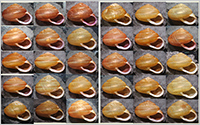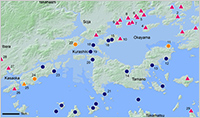Discovery of a remarkable new species of land snail restricted to arid environments in small islands and coastal areas of the central Seto Inland Sea, Japan
The islands and coastal areas around the Bisan Straits in the central Seto Inland Sea, between Honshu and Shikoku, are well known as semi-arid regions that have an extremely small amount of rainfall compared with other parts of Japan. Therefore, the diversity of land snail species is quite poor and no endemic species are known to exist in this region.
Notably, all species of land snails commonly found around the Bisan Straits are drought resistant. One of them, Satsuma ferruginea (Pilsbry, 1900) (Camaenidae), is found across wide areas of western Japan. The species is known to display geographic variation in morphology of the reproductive system and be confused taxonomically. Around the type locality of the species, that is, Kagawa and Okayama prefectures, rod-like and hook-like flagellum forms were recognized by an amateur malacologist Akira Tada.
Recent field surveys and molecular phylogenetic analysis by Yuichi Kameda and Hiroshi Fukuda showed that currently, the two forms have parapatric distributions and limited gene flow. The hook-form populations correspond to S. ferruginea, and the rod-form species was described as a new species S. akiratadai. Remarkably, S. ferruginea and S. akiratadai are not distinguishable in any external (shell and head-foot of animal) characteristics. Therefore, S. akiratadai has long been misidentified as being S. ferruginea. This is an exceptional case in the taxonomy of shell-bearing molluscs, because in most cases different molluscan species show differences in their shells.
Satsuma akiratadai is likely to be endemic to the islands around the Bisan Straits, because their current distribution is limited to islands and hilly terrain areas in the Okayama Plain that had been separate islands before an increase in sedimentation activity and artificial land reclamation since the 6th Century. Furthermore, S. akiratadai occurs in arid environments, suggesting that the species was diverged from S. ferruginea and adapted to the drier climate.
Thus, the distribution patterns of these two species are likely to reflect the unique environmental conditions and geographic history of this region.
Reference:
・Authors: Yuichi Kameda and Hiroshi Fukuda.
・Title of original paper: Redefinition of Satsuma ferruginea (Pilsbry, 1900) (Camaenidae), with description of a new cryptic species endemic to the coasts and Islands of the central Seto Inland Sea, western Japan.
・Journal, volume, pages and year: Venus 73, 15–40 (2015).
・Digital Object Identifier (DOI): None.
・Journal website: http://www.malaco-soc-japan.org/
・Affiliations: Center for Molecular Biodiversity Research, National Museum of Nature and Science, and Conservation of Aquatic Biodiversity, Graduate School of Environmental and Life Science, Okayama University.
・Department website:
http://www.kahaku.go.jp/english/institution/molecule/index.html
http://www.okayama-u.ac.jp/user/agr/profile/nougaku04_4.html
Figure caption:
Fig. 1. Shells of Satsuma ferruginea (left three columns) and S. akiratadai (right three columns).
Fig. 2. Estimated land areas around the Bisan Straits of about 1500–2000 years ago. Populations of Satsuma ferruginea and S. akiratadai are represented as triangles and circles. Populations with introgression and/or intermediate genital morphology are shown in orange symbols. Base map was drawn with Kashmir 3D (http://www.kashmir3d.com/) based on elevation data provided by Geospatial Information Authority of Japan.


